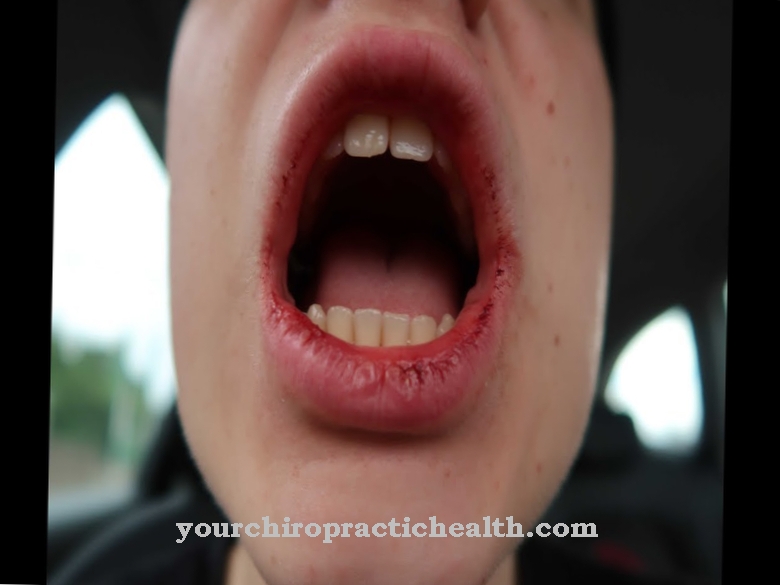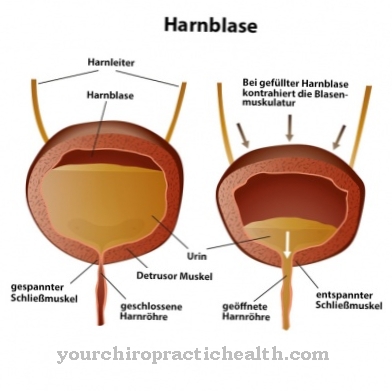The lies in the anterior chamber of each eye Chamber angle, in which the cornea, iris and eye chamber meet. The most important function of this structure is fluid regulation in the eye, which keeps intraocular pressure at normal levels. In diseases of the chamber angle, the fluid-regulating function of the structure can be disturbed, which increases the intraocular pressure and thus increases the risk of glaucoma.
What are the chamber angles?
The cornea, the iris and the anterior chamber of the eye meet in the anterior segment of each eye in an angular structure. This structure is called the chamber angle. The physician also speaks of the angulus iridocornealis, which is directly connected to structures such as the swallow line, the scleral spur, the ciliary body ligament and the trabecular structure.
The chamber angle allows the aqueous humor to drain, which the eye chamber produces to nourish the cornea. Diseases of the anterior chamber structure are often associated with blindness and usually involve impaired drainage of aqueous humor. In the so-called gonioscopy, the ophthalmologist checks the functionality of the chamber angle. For example, it controls the permeability of all chamber angle canals. In the event of a finding, he may be able to surgically lower the intraocular pressure with selective laser trabeculoplasty and thus avert serious secondary diseases.
Anatomy & structure
The doctor differentiates an unpigmented chamber angle component in the front area near the Schwalbe line from a further back and mostly colored component. The rear part is the functional part of the chamber angle structure and takes over the regulating tasks of the system. In short, the aqueous humor flows off in the posterior pigment part of the chamber angle. Among other things, this is where the so-called Schlemm's Canal is located, which is connected to the bloodstream in a sophisticated canal system.
The posterior part of the angular structures is also called the trabecular structure. The front part, on the other hand, is the swallow line. This is where the endothelium of the cornea meets the trabecular meshwork. This meeting creates a delicate, gray line. The white line between the trabecular structure and the ciliary body ligament is also called the sclera spur. This structure is often overlaid by pigment components and is therefore not directly visible. The ciliary body ligament is a mostly dark gray part of the ciliary muscle, which is located in the chamber angle between the base of the iris and the scleral spur.
Function & tasks
The so-called ciliary body sits in the corner behind the iris. This ciliary body permanently produces new eye fluid. It protects the eye from drying out and releases liquid into the anterior chamber. This liquid is used to nourish the cornea and is stored in the chamber. An excess of this fluid increases intraocular pressure and can have serious consequences. The task of the chamber angle is therefore to reduce the risk of increased intraocular pressure due to fluid breakdown.
For this reason, excess fluid is drained into the bloodstream through the channel system of the chamber angle. The Schlemm Canal plays a key role in this. This canal system is actually a circular vein between the cornea and sclera. Through this vein, the chamber angle can release water into intra- and episcleral veins, from where it is drained into the venous system.
The chamber angle in the eye thus primarily takes on a regulating role and thus ensures a balanced intraocular pressure. In addition to this main task, some structures of the chamber angle are also involved in additional functions. For example, the ciliary muscle ends in the ciliary body ligament at the chamber angle. This muscle system is responsible for deforming the lens, which is necessary for near vision. In the broadest sense, the chamber angle is therefore also associated with purely visual-related tasks.
Diseases
If the outflow of aqueous humor is disturbed through the corner of the chamber, the intraocular pressure increases. Almost all diseases of the chamber angle do not cause any pain, but only express themselves as a throbbing or pressing feeling of heaviness on the eyes.
In the case of diseases of the chamber angle, the doctor differentiates between a drainage disorder due to narrowed canals and a disorder due to an impairment of the fine-meshed trabecular structures. Most of the time, scarring, cystic changes, deposits or injuries are associated with a dysfunctional chamber angle. In acute cases, a disturbed chamber angle drainage can trigger a glaucoma attack by increasing the intraocular pressure.
Under certain circumstances, chronically increased intraocular pressure also leads to a classic glaucoma. In the worst case, this disease can ultimately blind the eye. In this context, the ophthalmologist also speaks of narrow-angle glaucoma. If, on the other hand, there are pathological changes in the anterior chamber angle canals, there is talk of a degenerative appearance of the trabecular meshwork, which can trigger chronic open-angle glaucoma. The chamber angle can also be affected by embryonic development disorders.
In this case, the Schwalbe line has malformations. A misshapen swallow line, in turn, often leads to congenital glaucoma. Sometimes there are also pigment deposits in the chamber angle. These changes may be related to pigment-dispersion glaucoma or a previous angular block attack. In rare cases, pigmented changes in the chamber angle can also be due to tumors of the anterior uvea.
Other diseases of the chamber angle are present when the vessels of the system assume abnormal growth forms. This often refers to diseases such as neovascular glaucoma or Fuchs heterochromic cyclitis. As in most other structures of the eye, a foreign body can also get lost in the corner of the chamber. If such a finding is present, the ophthalmologist usually removes the foreign body without damaging the surrounding structures.
You can find your medication here
➔ Medicines for eye infectionsTypical & common eye diseases
- Inflammation of the eyes
- Eye pain
- Conjunctivitis
- Double vision (diplopia)
- Photosensitivity

























.jpg)


